Bull Bay enters new world of discovery - Robotics ushers in opportunities for students
They placed wires strategically on the breadboard to create the circuit. As each LED bulb was inserted, it lit up in bright red, yellow, green or blue.
“The power is over here, so if you put [the bulb] behind it, it cannot get current – the current flows in front,” said Steve Solomon, an exuberant grade-six student.
Solomon went on to add that the breadboard is powered by a nine-volt battery that is attached to a motherboard.
He is one of 25 students at Bull Bay Infant and Primary School in St Thomas who were first exposed to robotics in September.
They have only done a term’s work but are well beyond the embryonic stage of development.
Grades five and six students were chosen for the programme and two sessions are held on a Monday afternoon in the school’s library.
A team of four assembled the frame of an Arduino truck. Come next term, they will place a battery pack on the frame to energise the motors, then use basic programming to make the motor move.
Robotics instructor Wayne Thompson told The Gleaner that the sessions aid in improving critical thinking and problem-solving.
“When they know that something should be lighting up or something should be moving, when it’s not moving, they know that they made a mistake and they ask themselves, ‘What did we do wrong?’”
Though other teaching aids exist, Thompson believes that robotics is one of the best options.
“Critical thinking, teamwork, interest in science, the entertainment factor that it brings to the classroom, it’s a win-win. They surprised me in many ways because I didn’t really expect them to be moving so fast,” Thompson said.
Business tycoons Glen Christian and Gary ‘Butch’ Hendrickson are leading a team that is seeking to raise more than US$1 million to establish the National STEM Centre for Research, part of a movement to increase buy-in and participation in science, technology, engineering and mathematics education.
That sector is said to have great job prospects, which will offer opportunities in the future for students like Bull Bay’s Lataya Sewell.
She recalled that the first time her team assembled the Arduino truck, it did not look like the model and so they reviewed their notes and tried again.
“I learnt that science is all around us and that robotics can help us in the future. I like that we can be a team and communicate with each other,” said Sewell, an aspiring nurse.
Kerry-Ann Walters, a grade-five student, said that science was one of her least favourite subjects until she began robotics.
“We do a lot of science in it and technology. I like that we have fun while we work,” Walters said.
She hopes that as she continues robotics, she will be better prepared for the Primary Exit Profile (PEP) examinations she will sit in the next academic year.
Principal Justin Duncan said it was necessary to begin the programme as robotics is gaining momentum across the world, and he is aiming to produce 21st-century-ready students.
Robotics, he said, was also an embodiment of the skills needed for the Fourth Industrial Revolution – creativity, collaboration, communication and critical thinking.
“We recognise that most of our students are slow, and as an educator, I believe that we have to cater to the different types of learners. Some learn by seeing, some learn with their hands or things that are interesting to them, and that’s what we use to increase learning,” the principal of five years explained.
Duncan, a Technical and Vocational Education and Training (TVET) educator, noted that the performance task component of PEP is better approached by students who have extensive experience with problem-solving, technology, and science.
“We are changing the face of Bull Bay and what we are putting out there. We are putting critical thinkers out there,” he said.

